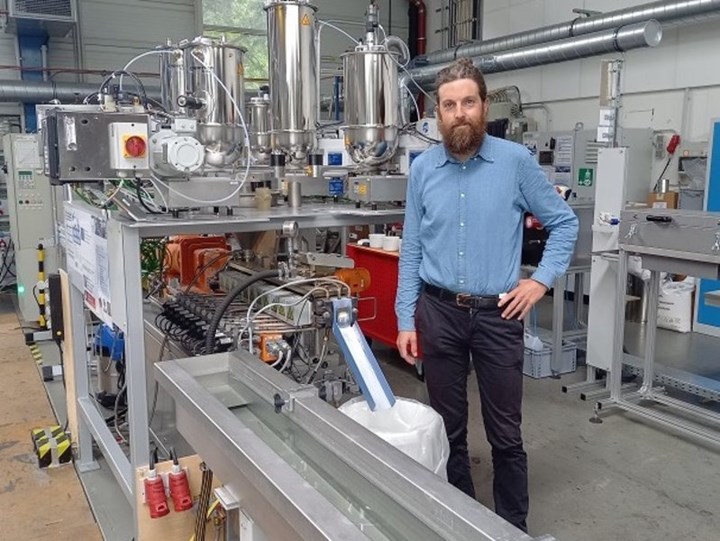Fiber Institute Bremen develops high-strength PLA biopolymers
Novel PLA blend is proven on pilot plant scale for technical textile applications like aerospace, medical or automotive engineering.

Dr. Boris Marx producing PLA blend with a stereo-complex crystal structure at the Fiber Institute in Bremen. Photo Credit: AIF
Technical fibers make the ropes of children’s swings safe or are indispensable in medical operations. The base material for these fibers are often petroleum-based polymers. In view of the limited availability of fossil raw materials and challenges with plastics, Dr. Boris Marx from the Fiber Institute Bremen eV (FIBRE, Germany) is looking for alternatives with biopolymers. He is one of the nominees for the 2022 Otto von Guericke Prize Scientists for special innovative achievements in the field of pre-competitive industrial joint research (IGF) — which builds a bridge between basic research and commercial application — funded by the Federal Ministry of Economics via public funds.
Biopolymers such as polylactide (PLA) consist of bio-based, renewable raw materials and, in contrast to the usual polymers made from petroleum, are biodegradable. PLA is made by chemical synthesis based on lactic acid. Commercially available PLA is processed into yarns that can currently be used for home textiles, for example. However, the strengths for technical applications are not yet sufficient.
“As part of the IGF project ‘high-performance PLA-Biko fibers,’ it was possible for the first time to produce a PLA blend with a stereo-complex crystal structure on a pilot plant scale,” Dr. Marx explains. “Two PLA starting materials were mixed in the compounding process. The special feature lies in the process control at the temperature. The result is a PLA blend in powder form with a stereo complex crystal structure, so that yarns with higher strength and stiffness can be developed and conventional plastics can thus be substituted.”
According to Dr. Sven Oberhoffner from ITV Denkendorf Produktservice GmbH (Denkendorf), “The research results achieved in the project are of great importance for medical technology and especially for us as a developer and producer of innovative textile implants. This is because there are currently no PLA-based products on the market in a stereo-complex form. The PLA blend now available enables the development of new and innovative products such as improved osteosynthesis plates for the treatment of fractures. We hope that this will expand our product portfolio and open up new markets.”
Professor Axel S. Herrmann, institute director of FIBER, notes that the material is intended for high-tech sectors such as aerospace technology, medical technology or automotive engineering. Since the material was developed in an industry-oriented pilot plant, the parameters that were researched can also be easily transferred to industry — this is currently being done with the project support committee together with small- and medium-sized companies and the AiF member Research Association Materials from Sustainable Raw Materials eV - WNR.
Related Content
-
Moving toward sustainable automotive parts manufacturing
How can the automotive supply chain prepare for future sustainability requirements? Tier 1 Kautex Textron discusses emissions reduction, design for circularity and transition to recycled/bio-based plastics.
-
JEC World 2025 highlights: Evolving recycling and biomaterials technologies
CW technical editor Hannah Mason shares sustainability-focused composites trade show highlights featuring maturation, scale-up, new partnerships, and new technologies in biomaterials and recycling.
-
Super Resin Inc. highlights plant-based epoxy resin, foam core
Eco-friendly resin system using glycol lignin offers an eco-friendly option for CFRP structures and components, and core materials.
















